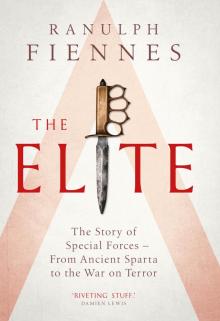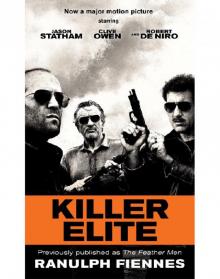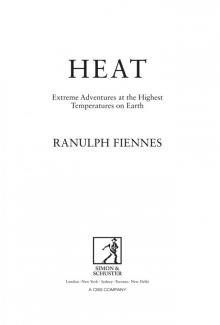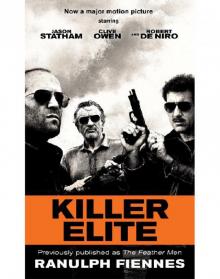- Home
- Ranulph Fiennes
Killer Elite (previously published as the Feather Men) Page 12
Killer Elite (previously published as the Feather Men) Read online
Page 12
Patrick Tanner’s alarm sounded at 4 a.m. He left a thank-you note to the Masons on his bedside table and descended to the study for the safe-room key. David had told him exactly where to find it. Quietly, lest David’s father should be a poor sleeper, he unlocked the heavy safe-room door, disabled the inner alarms and, with admiration and a touch of envy, surveyed the guns that lined the walls. He was thankful for the checklist David had given him the previous year. On that occasion he had retrieved the Colt Python .357 Magnum revolver.
There were a number of shotguns—.410s, 20-bore and 16-bore—but the prize items were a pair of 12-bore Purdeys with thirty-inch barrels and made in the 1920s, the best period for English game guns.
Patrick smiled as he read through the checklist. David was a connoisseur. The list was almost a homily:
S&W .45 ACP
Auto, 9 shot. Good auto, quick firing, etc., but like all autos is more prone to jamming than a revolver.
Walther PP
.32 caliber. Excellent small auto, but needs very accurate shot (or 2 to 3 rounds) to stop quarry. Any pistol with a smaller caliber than this is frankly of no use for anything other than firing into one’s mouth if one needs a new tooth filling.
Walther .22LR
Semiauto rifle with sound moderator (silencer) for vermin (ideal for rabbits).
Colt Python .357 Magnum
Revolver. Heavy and deadly accurate. I get four-inch groups at 100 yards. The best revolver made. Fires heavy 160-grain slug.
Stephen Grant .22 Hornet
For slightly larger vermin. Deadly accurate up to 120-150 yards, then trajectory falls off quickly. Converted by J. Rigby & Co., from the original .250 “rook rifle” caliber.
Parker-Hale .243
Rifle. Cheap but accurate. Good flat trajectory for vermin out of range of .22 Hornet.
Rigby .275
Mauser action rifles. I have three of these, one with an extra-long barrel and two with standard barrels. Superb rifles, ideal for deer-stalking. One has a Zeiss 4 × 40mm scope, one a Pecar 4 × 30mm, and the long-barreled one has open sights only.
Daniel Frazer .303
Double rifle. Collector’s item. Very accurate.
Rigby .350 Magnum
Mauser action rifle. Oldish (1920s). Very reliable. Open sights. For big game.
Rigby .375 H&H Magnum
Rifle. Converted from .350 special (an obsolete caliber). Marvelous rifle—will stop just about anything. Kick like a mule. 1.5-6 × 40 Zeiss scope.
Pair of Purdey .450
Double rifles. Collector’s items (turn of the century).
Rigby .470 Nitro Express
Double rifle. Fantastic weapon. Beautifully made (c. 1930). Mint condition—very valuable. Will stop anything. Makes a noise like a nuclear explosion when fired (500-grain bullet @ 2,150 fps).
You will notice from the above that most of my rifles are made by John Rigby & Co. For a century now they have in my opinion been the best riflemakers of all (they still are) although in terms purely of accuracy rather than quality of workmanship there are quite a few other good names.
Those are the rifles and handguns I have at the moment. As far as military weapons are concerned, my favorite is the Russian AKM assault rifle (brilliantly simple, no-nonsense design, never jams, small and maneuverable, lightweight ammo, etc.), and my least favorite is anything that has been issued to the British Army since they replaced the .303 Lee Enfield rifle and Bren LMG, with the honorable exception of the L42 sniper’s rifle and to some extent the GPMG, although both would be better if they used .303 ammunition modified to rimless, instead of .308 Winchester (7.62mm NATO). The SLR, the Sterling SMG and the Browning 9mm “Hi-Power” auto pistol are all badly designed, fault prone, bloody awful weapons, although the silenced version of the Sterling has its uses …
Patrick folded away Mason’s note, unclipped the .22 Hornet from its rack and removed sufficient materials and tools to make up ten rounds of .22 ammunition from a box in the drawer immediately below. He selected a hardened-plastic rifle case from the relevant rack and spent the better part of an hour centralizing the smaller items on David’s ancillaries list. Finally he removed a battered brown suitcase containing clothing. Not all the gear Mason had requested was in evidence but Patrick had put together a shopping list to attend to later in the day. He replaced the keys, let himself out of the house and drove his VW camper as quietly as the gravel allowed down the driveway of Eynsham Park.
At 5 p.m. on March 4, having handed over his duties as early as was feasible, David Mason left Wavell Barracks in a hurry. He was technically seven hours AWOL since his two weeks’ leave did not officially begin until midnight. Fifteen minutes later he arrived at Checkpoint Bravo, entry point to the Berlin Corridor, and frowned with irritation at the line of cars awaiting document checks. He jumped the queue and flashed his ID card at a queuing burgermeister type who showed signs of indignation. The RMP duty warrant officer was immediately on hand and Mason passed him the two-thousand-Deutschmark traveler’s check to which he had previously agreed in return for keeping a space for 4:30 p.m. for Mason’s green Porsche 911, British Forces Germany registration number EZ 242 B. The warrant officer took details of Mason’s BFG license, his ID, and Green Card insurance cover. The Berlin Corridor system was rigidly controlled to ensure that no driver had time to spare, after leaving the checkpoint at either end of the corridor, to leave the road for nefarious purposes, such as smuggling locals to the West.
The regulations also ensured that no speeding could take place by stipulating a minimum time limit of two hours for the hundred-mile drive. Mason left the checkpoint at 5:30 p.m., not at 4:30 as stamped on his pass by the warrant officer. He was therefore able to average a hundred miles an hour along the potholed corridor and still arrive at the “correct time” of 6:30 p.m. at the Helmstedt Volkspolizei checkpoint out of East Germany.
The East German border guards were perfunctory in their check, and the British NCOs at Checkpoint Alpha passed Mason through without a second glance. He then settled down to some serious autobahn driving via Hanover, Dortmund, and the Belgian border at Aachen, passing through that unmanned border post at 135 mph.
He reached Zeebrugge at 10:15 p.m. and caught the 11 p.m. ferry. On board he purchased twelve rolls of Kodak Tri-X film and four rolls of Ilford FP4 film, both 35mm, at the duty-free shop and slept for two hours.
After clearing Dover Customs at 4:30 a.m., he set off along the A2 and M2 to London, then, via the M4, to Heathrow, where, at 7 a.m., he drew up behind Patrick’s VW camper on the access road to the long-term car park.
Inside the curtained and locked rear of the van the two men drank black coffee from Patrick’s vacuum flask and Mason lit up a cigar and placed the .22 rifle, with all the other items that Patrick produced, on the camper’s kitchen table. He carefully explained to Patrick exactly what must be done over the next two hours.
Patrick switched on the car’s ignition to activate the extractor fan in the hope that it would deal with the cigar smoke before he died of asphyxiation and to ensure that their conversation was inaudible outside the van. A BBC newscaster wished them good morning with the news that thousands had died in an earthquake in Romania.
The rifle, Mason explained, had been manufactured by Stephen Grant & Son of 67a St. James’s Street, London, in the early 1930s. It had been made as a .25 rook rifle and was later rechambered for .22 Hornet bullets. The outside of its barrel was octagonal, giving it an antique appearance that belied its efficiency. The action worked from a side lever and opened like a modern shotgun, being single-shot, not magazine-loaded.
To dismantle the weapon, Mason removed the wooden fore-end piece in front of the trigger guard and, breaking the gun by pushing down the side lever, he hinged the barrel down and away.
The camper’s built-in cooker had two gas rings over which Mason held a twenty-four-inch length of one-eighth-inch-diameter 8 SWG steel rod, and in his other hand, the barrel of the rifle. Patrick heated a b
lack candle so its melted wax dripped down into an eggpoacher.
Mason smeared a chewed wad of gum with engine oil and pushed it into the barrel’s muzzle end. He then held the heated barrel upright with its muzzle on the floor and inserted the twenty-four-inch rod into the twenty-six-inch barrel until it disappeared. He shook the barrel lightly and the rod rattled audibly. Patrick then poured the melted wax into the barrel through a funnel so it filled the entire area between the rod and the inside wall of the rifled barrel. Once the rifle and the rod cooled down, the wax solidified and the rod was rigidly sealed into position.
Removing the wad of gum, Mason applied varnish with an artist’s brush to both ends of the captive rod, dabbed on gun-black as a final camouflage coat, and tapped both ends of the rod with a screwdriver. The effect was that of a police-plugged barrel. To all intents and purposes the weapon was now merely a decommissioned antique. As such, it could travel legally and document-free as air cargo. Mason reassembled the rifle, having first removed the firing pin and mainspring. Then he locked it into the plastic rifle case and stubbed out his cigar.
“The next stage,” he told Patrick, “will take longer.” He removed four cassettes of Ilford FP4 film with their plastic containers and began to force their tops off gently with a standard bottle opener. “I wasted hours when I first tried this with Kodak cassettes. They come off okay but they’re buggers to reassemble. Also the hollow area inside the spools of these Ilford cassettes is more spacious.”
Mason used a modeling knife to cut away the main central portion of the take-up spool. He retained only the now truncated ends, each of which looked rather like a miniature black top hat. He set Patrick to work on a second Ilford cassette and turned his attention to the components of the ten .22 Hornet bullets. First the empty cases, new and unprimed. These he prepared one by one with Eley primers by placing a primer onto a Lyman ram tool and pushing it firmly down into an empty case held in the slot of a Lachmiller priming clamp. When five of the cases were primed, he bound them into a tight bundle using surgical tape. He then positioned an Ilford spool “top hat” on either end of the bundle and forced it into the original Ilford cassette casing. The caps, which he had earlier removed by bottle-opener leverage, he now replaced by simple pressure until they once again mated over and around the “top hats.” Since the Hornet cases were exactly thirty-five millimeters in length, they fitted with precision into the space vacated by the film.
The finished cassette looked as good as new, although it now weighed thirty-three grams instead of twenty. When Mason had primed the remaining five empty cases, he fed them into the guts of the cassette that Patrick had successfully doctored. Cutting five inches of film leader from one of the discarded films, he inverted it to protrude in the normal manner. Loading the cassette into one of his Olympus OM-1 cameras, he made sure that the leader covered the camera’s take-up spool without actually entering the winder slot. After closing the camera he pulled back the film-advance lever a dozen times. Although the film itself did not move, the exposure-counter window now registered 12. He fed the second camera with the other five disguised bullet cases. On the security X ray, the intricate components of the cameras would disguise the presence of the cartridge cases.
Only the bullets themselves and the gunpowder remained to be dealt with. Mason used small balance scales to weigh out eleven grains of IMR 4227 gunpowder, which he poured into a small, square plastic bag labeled “Silica-gel Desiccant.” He sealed the bag with instant glue and repeated the process twelve times, allowing two extra bags for damage or wastage at a customs inspection. The bags went into a side pocket of Mason’s camera case. If inspected for drugs, the gunpowder was tasteless and, like silica gel, hygroscopic. The case also contained a fold-away developing tank, trays, chemicals, paper, and the parts of an enlarger.
The ten Hornady forty-five grain (2.9 gram) .22 Hornet hollow-point bullets fitted perfectly into the central space of two packets of Polo mints that Mason put into his trouser pocket.
Thirty more minutes were spent checking and packing all the equipment, and at 8:50 a.m. Patrick left Mason at the Terminal 3 Departure Lounge. The Gulf Air check-in counter took his large suitcase and the rifle case as cargo baggage and he passed through to Emigration.
At the X-ray machine, Mason placed his hand luggage on the conveyor belt and entered the walk-through metal detector, which bleeped loudly at him. A security officer had him empty his pockets onto the side table and try again. Next time the machine was silent but he was “patted down” and the contents of his pockets were checked item by item. These consisted of keys, wristwatch, steel Parker pen, coins, sunglasses, penknife, handkerchief and Polo mints. All were passed as innocent.
Mason’s hand baggage was opened by an efficient lady in a well-filled gray sweater. She switched on his razor, dictaphone, and radio and inspected his cameras and lenses with care. She ignored the silica-gel bags and various other small, harmless-looking items.
As soon as Mason finished with Security he headed for the toilets in the Departure Lounge, where he taped a polythene bag to the inside of one of the cisterns. The bag contained all his “guilty” items, including bugging gear, firing pin, Polos and doctored cassettes. He reloaded his cameras with genuine Ilford film.
No sooner was he seated behind a newspaper in the Departure Lounge than his name was called out on the Tannoy. He must return to Security. Once there he was taken to a side room and confronted with his rifle case. This he unloaded, explaining that the gun was a decommissioned antique for which he had an exchange-buyer in Muscat. He intended to bring back a six-foot-long matchlock if the sale went well.
The officers seemed satisfied but rechecked all Mason’s gear. This went ahead without a hitch and he returned to the toilets to retrieve his equipment. He recalled that the previous year he had felt guilty during the recheck en route to Cyprus. This time he had been troubled by no such twinges.
Davies had still not boarded by the time of the last call for their flight, but Mason spotted and identified him with considerable relief soon after it was made. The Welshman traveled First Class, Mason in Economy.
The TriStar was half full until Doha but then filled up, mostly with Asians, for the final legs to Dubai and Muscat. It touched down at Seeb International Airport shortly before midnight. The night air was cool, and Davies was met by a cab driver holding a name board. While Davies returned to await his baggage amid a milling bustle of Asians, Mason asked the Welshman’s driver if he was free.
“Sorry, sah’b, I take another man to Gulf Hotel. But no worry. Many more taxi outside for you.”
Mason relaxed. Spike already had him booked into the Muscat Gulf, the best of the only three available hotels in all Oman. There was now no need to worry if Davies’s bags appeared before his own.
14
Bill Bailey, Chief Superintendent of the Air Wing of the Royal Oman Police, watched the helicopter disappear toward the mountains on an emergency medical evacuation requested by the Army. He had sent John Milling because no one knew the Jebel Akhdar better.
Most of Bill Bailey’s helicopters were Augusta Bell 205s, modeled by the Italians on the American Huey and extremely reliable even when flown well beyond their specified limits. They were designed to carry, under normal conditions, a maximum of twelve fully equipped men but Bill had once counted twenty-four Dhofaris, all with bundles of personal gear, spill out of one.
Bill knew John Milling of old, for both men had served with the Royal Marines in Europe. John had not been his normal cheerful self the last couple of days, and Bill put this down to the recent news of the death, in a helicopter crash, of Queen Noor of Jordan. During a royal visit to Oman the previous December, John had flown Queen Noor to all the main places of interest and grown to like her. Most of his pilots, Bill knew, would simply have said, “How sad.” But John took such things very much to heart. If he liked you, he was the most loyal of friends. A bit of a romantic too, Bill had always thought. It was probably due to hi
s genes: he came of a devoutly Protestant family from Ballymoney, in Northern Ireland, where his father was the North Coast Warden for the National Trust. Tall and very good-looking, John had conquered more than one heart on his travels over the years.
The reason for his current introspective mood had in reality nothing to do with the late Queen of Jordan and everything to do with his wife. Bridget, or Bridgie as she was generally known, was seven and a half months pregnant with their second child and showing worrying signs of a premature delivery. With the leaden heat of the Oman summer less than a month away, John was anxious for Bridgie to have the child in Europe, and until then he must ensure she was treated like porcelain.
A natural sportsman, John had rowed at Henley for his school and then joined the Commandos. After service in the Far East he was seconded in 1969 to the Sultan’s Forces and decorated for bravery under fire. For a while he flew helicopters in the West Indies until, leaving the Royal Marines in 1975, he joined the Air Wing of the Royal Oman Police. After eighteen months his restless soul was already becoming bored. He sought new and distant horizons.
The Bell flew through the Sumail Gap. To the south lay many hundreds of miles of sand and igneous rock, the Wahiba and Sharqiya regions; to the north the great escarpment of the Jebel Akhdar and Nakhl. On landing at Izki camp, John collected a generator spare part, then, departing slightly from his official flight plan, flew north for the lush gardens of Birkat al Mawz, Pool of the Plantains. To the delight of his Omani crewman Ali, they headed for a valley that cleft the sheer face of the Jebel Akhdar, ten thousand feet high.

 The Elite
The Elite Killer Elite (previously published as the Feather Men)
Killer Elite (previously published as the Feather Men) Heat
Heat Killer Elite
Killer Elite